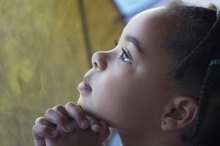Activities That Teach Kids to Love Others
As much as you love and demonstrate that love to your children from the minute they are born, understanding the concept of loving others can be difficult for young children to grasp. You can teach and reinforce lessons on love to your child by engaging her in activities that promote loving others through kindness and friendship.
Loving Stories
Read books with your child that emphasize love through friendship. For example, for kids ages 4 and older, the book "You: A Story of Love and Friendship," by Stephen Michael King, uses simple prose to inspire children to show love toward each other 1. If you want to instill the message of loving each other from a biblical point of view, check out, "Loving One Another: Beginner's Stories About Being a Good Friend," by Neta Jackson, also for ages 4 and older 2. The book features stories from a Christian perspective on loving one another, including Bible verses.
Crafting with Love
Salvation Activities for Kids
Learn More
Encourage your child to show love to a friend by making a craft for her. One idea is to make a beaded friendship bracelet. Have your child use beads that are in her friend's favorite colors. She can also make a matching bracelet for her friend. Another idea is to make a friendship blossom flower to representing a new, blossoming friendship. Help your child to cut out flower petal shapes out of colored card stock. Poke a hole in the center and stick a small lollipop into the center. Your child can write a note on the petals for her friend as well.
- Encourage your child to show love to a friend by making a craft for her.
- Help your child to cut out flower petal shapes out of colored card stock.
Loving the Community
Show your child that loving others can also mean showing love and compassion for the less fortunate in your community. Find an age-appropriate volunteer opportunity where you and your child can give back to the community in some way or the other. Ideas include serving meals at a soup kitchen, sorting cans at a food back , organizing a winter coat drive, or collecting toys for children that are stuck in the hospital on Christmas. Talk to your child about how it feels to be show kindness and love to those who really need it.
- Show your child that loving others can also mean showing love and compassion for the less fortunate in your community.
- Talk to your child about how it feels to be show kindness and love to those who really need it.
Love Games
Meekness Activities for Kids
Learn More
Engage your child and her friend in interactive games that also reinforce the importance of friendship and love. For one game, have the kids sit in a circle and give each child a pencil and a piece of paper. They must write down 10 kind things about the person to their right as fast as they can. The person who finishes first gets to go first, but they all get to read their list and give their paper to that person. For another game, take the kids outside in a large space. Two kids are the "friendship stealers," and the others are on one side of a field and must run to the other side to safety without getting tagged by the friendship stealers. If any child gets tagged, they must remain frozen until a teammate tags them. The kids cannot get on safety without everyone, reminding them to never leave a friend or someone you love behind.
- Engage your child and her friend in interactive games that also reinforce the importance of friendship and love.
- Two kids are the "friendship stealers," and the others are on one side of a field and must run to the other side to safety without getting tagged by the friendship stealers.
Related Articles
References
- You: A Story of Love and Friendship; Stephen Michael King
- Loving One Another: Beginner's Stories About Being a Good Friend; Neta Jackson
- Moreman, RD. The downside of friendships: Sources of strain in older women's friendships. Journal of Women and Aging. 2008;20(1-2):169-187. doi:10.1300/J074v20n01_12
- Bowker JC. Examining two types of best friendship dissolution during early adolescence. Journal of Early Adolescence. 2010;31(5):656-670. doi:10.1177/0272431610373103
- Johnson, AJ, Wittenberg, E, Haigh, M, Wigley, S, Becker, J, Brown, K, Craig, E. The process of relationship development and deterioration: Turning points in friendships that have terminated. Comm Quarterly. 2004;52(1):54-67. doi:10.1080/01463370409370178
- Brent LJN, Chang SWC, Gariépy J-F, Platt ML. The neuroethology of friendship. Ann N Y Acad Sci. 2014 May;1316:1–17. DOI: 10.1111/nyas.12315.
- Melis AP. The evolutionary roots of human collaboration: coordination and sharing of resources. Ann N Y Acad Sci. 2013 Sep;1299:68–76. DOI: 10.1111/nyas.12263.
- Seyfarth RM, Cheney DL. The evolutionary origins of friendship. Annu Rev Psychol. 2012;63:153–77. DOI: 10.1146/annurev-psych-120710-100337.
Resources
Writer Bio
Based in Los Angeles, Zora Hughes has been writing travel, parenting, cooking and relationship articles since 2010. Her work includes writing city profiles for Groupon. She also writes screenplays and won the S. Randolph Playwriting Award in 2004. She holds a Bachelor of Arts in television writing/producing and a Master of Arts Management in entertainment media management, both from Columbia College.









